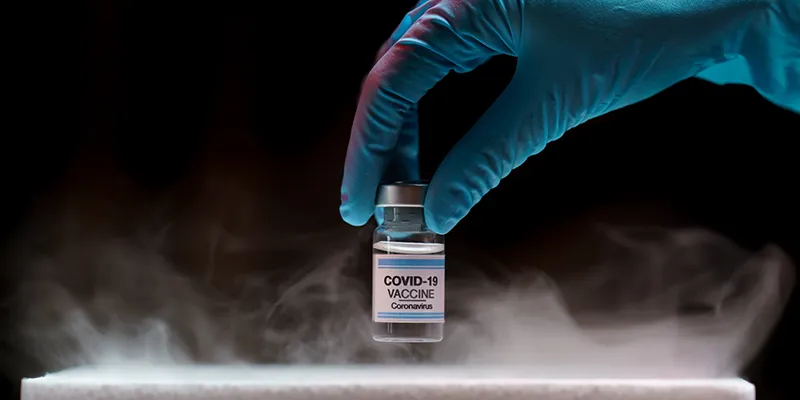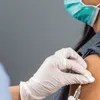COVID-19 vaccine: All you need to know before May 1 when every Indian adult is eligible for a shot
From infrastructure to availability, foreign vaccines, costs, and myths, here is everything you need to know about what happens when the next COVID-19 vaccine rollout begins in India on May 1.
On May 1, India’s entire adult population, estimated at a staggering 842 million, will become eligible to take the COVID-19 vaccine. The vaccine rollout in the country began in January 2021 in a phased manner with frontline workers of all ages being the first, followed by senior citizens and people with comorbidities above the age of 45, and then those without comorbidities above the age of 45.
This next phase will include those between the ages of 18 and 45 – the country’s largest age demographic.
With the number of infections increasing rapidly, infrastructure stretched thin, and reports of shortages in the supply of the vaccine doing the rounds, what can one expect as the ‘world’s largest inoculation drive’ expands to every adult citizen? Will the target of inoculating 250 million Indians be achieved by July 2021?

On May 1, all Indians above the age of 18 will become eligible to take the vaccine. The vaccine is not available for minors yet. Image: Shutterstock
Infrastructural outlook
Speaking to Social Story, Dr Shuchin Bajaj, Founder-Director, Ujala-Cygnus Hospitals, a chain spread across Delhi, Haryana, Uttar Pradesh, and Uttarakhand, says, “Most vaccination centres are currently located inside hospitals and the staff is at a breaking point with all the COVID-19 cases coming in. So, I hope that vaccination centres are expanded to include primary care clinics and small centres. This will not only smoothen the drive but also make things more accessible because people are scared to go into hospital right now.”
He believes that the strict protocols around the vaccination centres might pose a challenge for smaller centres. “Vaccination protocols that have been set up are quite strict. For one, they need three rooms – a waiting room, a vaccination room, and an observation room – with a minimum area requirement. The observation room needs to have medical equipment, including a crash cart and resuscitation equipment, which small clinics and outreach camps will find difficult to organise.”
Citing the example of India’s extremely successful Pulse Polio Drive, which was initiated in 1978, Shuchin believes that India has the wherewithal to complete millions of vaccines in a day.
Raghavendra Prasad TS, Founder of Project StepOne, a non-profit collective of over 7,000 doctors, which launched a National Covid Telemedicine Helpline, offering 24x7 access to healthcare experts free of cost, says that despite nearly four million vaccines being administered a day, the urgency of the situation requires that nearly three times that many doses need to be administered daily.
“For this to happen, you have to get the community involved. This is an issue that affects the community and the government should allow Resident Welfare Associations, faith-based organisations, and even NGOs at the rural level to drive this initiative,” says Raghavendra, agreeing with Shuchin that the strict regulations around vaccination centres need to be relaxed to accelerate the drive, and that appeals have been made to the government in this regard.
Addressing concerns about immediate side effects, Shuchin believes that we may have erred too much on the side of caution. “Of the millions of doses that have been administered, there are only single digits where people have needed instant emergency care. So, I think we just need to widen the scope and make it available at every pharmacy, every clinic, even go door to door. That’s the only way to do it,” he says.
Availability and supply
Among the bigger concerns that Indians have is that the vaccine could simply run out and those seeking their second dose will have to wait. Shuchin believes that people need not be concerned as with all vaccines, it’s better to take the second dose ‘later rather than sooner’.
Regarding the rumours that centres are offering Covaxin as a second dose to people who took Covishield in the first round, and vice versa, citing lack of availability, he believes that it’s likely to be hearsay. There is absolutely no clinical evidence to show that the two vaccines work well together.
“I would strongly caution against it as it is not even under trial at this point. Pfizer and Covishield are being trialled together in the UK to see whether there is a better response to combined vaccines, which is how Sputnik V has been developed, but there is absolutely no evidence to recommend Covaxin and Covishield being administered together,” he warns.
Shuchin also says that there is no preference being given to first- or second-time recipients. “There is no directive at a top strategic level or even at the vaccination centre, which is quite mechanical in how it functions. If they have the vaccine you need, you will get it as scheduled.”
“However, the fact that we have an inkling that there will be no walk-ins allowed after May 1 is something that may then be regulated at a higher level to see who gets the appointment first,” he says.
He reiterates that people should not panic and go early for the vaccine. “The thumb rule with any vaccine is that it’s better to wait. If they say wait four weeks, it’s better to take it after five than after three.”
Dr Harish Pillai, CEO of Aster India, Aster DM Healthcare, says, “Currently, all private hospitals along with their national associations are collectively in conversation with vaccine manufacturers to arrive at a comprehensive plan for procurement and distribution. Discussions are still ongoing. Our primary focus is to ensure continuity of supply at the bare minimum and accelerating the pace of vaccination as production and availability by the manufacturers improve. A large percentage would be domestic manufactures and some might be imported.”
Cost and cold chain
Raghavendra believes that one area where the government must be commended is encouraging the manufacture and availability of two indigenous vaccines. “I don’t think any country has been able to really do that. Neither Pfizer nor Moderna are actually US vaccines. I think many manufacturers were looking at India as a huge market to recoup their COVID losses. The vaccines in the US cost around $30, so we would have been paying over Rs 2,000 for a single dose.”

The vaccines manufactured in India can be stored at temperatures far higher than Pfizer and Moderna. Pfizer has to be stored at -70 degrees C, which is colder than Antartica. Image: Shutterstock
He adds that when Sputnik V and the other vaccines enter the market, the common man is unlikely to be able to afford them. “They are not here for the masses and they will need to be profitable, so it’s a good thing that we have managed to vaccinate so many of our people either free or at affordable rates.”
He does not anticipate the other vaccines entering the country any time soon as India still does not have the cold chain capability to preserve these vaccines (Pfizer needs to be stored at - 70 degrees C and Moderna at -20 degrees C vs. 2-8 degrees C for Indian vaccines).
However, Indian vaccines are also likely to see an increase in price starting May 1, 2021.
Until April 30, the entire vaccine supply will be routed through the Centre to its vaccination centres, government hospitals and private hospitals. Beginning on May 1, only half the vaccines will go to the Centre, while the rest will go to the state governments, private hospitals, and the open market at a price set by the manufacturer.
In a statement released on Twitter on April 24, Adar Poonawalla, CEO of the Serum Institute of India, which manufactures Covishield, explained the decision to sell the vaccines at Rs 600 per dose to private hospitals, Rs 400 to states and Rs 150 to the Centre saying the situation was “dire; the virus is constantly mutating while the public remains at risk...we have to ensure sustainability as we must be able to invest in scaling up and expanding our capacity to fight the pandemic and save lives.”
Krishna Ella, Chairman and MD, Bharat Biotech, has also been quoted as saying he would like the ‘maximum possible price for the vaccine’, which is already retailing at $15-20 in international markets and will be sold to the state governments at Rs 600 and Rs 1,200 to private hospitals. The reason he cites is future R&D and to recoup the cost of developing the vaccine including the Rs 350 crore spent on clinical trials.
Myths and reality
With the initial vaccine hesitancy having come down because of the severity of the pandemic, Harish says that more people are coming forward and seeking vaccinations. “There are still some unfounded fears on account of half-knowledge or misinformation in social media, mainly to do with reports of adverse events which is largely reported in Indian media and western media which for a population of our size is statistically insignificant,” he says.
From blood clots to infertility, and autism to body odour, the apprehensions range from seriously cautionary to comical.
“We ran a radio programme in Delhi on RedFM called ‘Nation ka Vaccination’ with RJ Raunak to dispel some of these myths, including that it brings down your immunity,” says Shuchin.
People relying on herd immunity may also be living under a misapprehension.
“The government, largely based on the opinion of experts, was hoping to vaccinate 60 percent of the population, relying on herd immunity. This second wave has effectively debunked that theory. We should be aiming at getting 80 percent of our population vaccinated. That is the most important thing and that means doing 10x of what we are doing now,” says Raghavendra.
(with inputs from Anju Ann Mathew)
Edited by Saheli Sen Gupta








